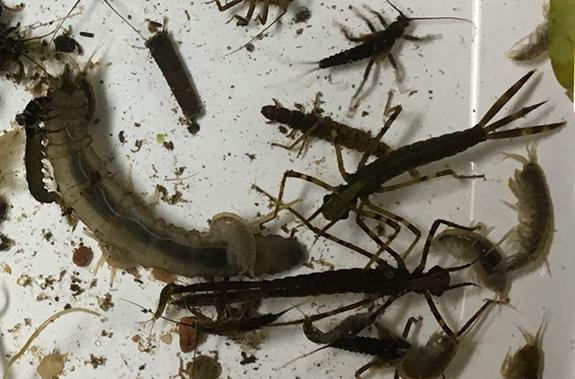Spending time out in the streams becomes almost a necessity now that the early season is underway. Preparation is not difficult, just dress warm enough, as the snow along the trails is not deep. Plan on fishing subsurface with a minimum of line retrievals into the rod guides. Otherwise, in these freezing temperatures, the fly line becomes a rope of ice, solidified into the guides. From the bank, it is always puzzling to perceive what is occurring within the depths of streams. Sporadic reflections or bulging swirls near the surface from feeding trout are infrequent indictors of stream life, at least life from a trout or fisher’s point of view.
To understand what trout will chase as food does require a bit of investigation by pulling rocks and lifting logs within runs, pools and riffles. In doing so it was like reading a calendar of key hatch events for the next five months. The leaf packs draped over tree limbs harbored midges (February emergers) and winter stoneflies (March / April emergers); riffles held numerous Hendricksons (April / May emergers), American Grannom (May emergers), March Browns and Spotted Sedges (June emergers). Without deference for certain months scuds, midges and blue winged olives fill in the months across all seasons. There it is, the plan for the forthcoming season.
This is an outstanding line-up for the coming seasons that only hint at the diversity of the macroinvertebrate community common to many Central Wisconsin streams. Within many of these bug groups there are numerous species. Many species have the same ecological function, which builds robustness into the community structure.
The different species, with their own strengths and adaptations assure continued stream function (incoming energy transformation and passage from sunlight to trout biomass) when adversity distresses one species more than the other. The American Grannom (sometimes locally referred to as Black Caddis) for example are Brachycentrus, which is comprised of four species in Wisconsin: americanus, lateralis, numerosus and occidentalis.
All four species function to filter organic bits of plants and detritus from the stream and thereby convert themselves into tasty morsels that swim to the surface and flutter about causing fishers to create imitations used to tease trout. Several of these four species are spring emergers, while others are on the wing in smaller numbers during mid-summer, in doing so they are separated in time.
One species is further separated from others by preferring headwater streams - these characteristics and preferences prevent direct competition among the species and maintain stream function.
It certainly is not necessary that observations such as these be conducted prior to fishing. However, the value in sampling bugs is to aid your future planning and define locations to revisit at specific times. So as we hope for warmer days in February for fishing, this time of year is always good for tying flies for spring and summer fishing.


